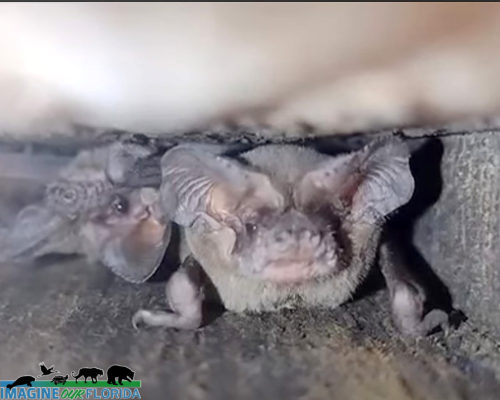The Brazilian free-tailed bat, also known as Tadarida brasiliensis, and some even refer to them as Mexican free-tailed is a species of bat found throughout the Americas, from southern Canada to central South America. It is a medium-sized bat with broad ears, large feet, and the end of its tail free, hence the name “Free Tail”. The bat is easily distinguished by its tail which extends for about half its length beyond the tail membrane. They have short, velvety, reddish-to-black-colored fur. Some of them have patches of white scattered throughout their fur. The ears are short, broad, thick, leathery, and separated in the middle of the forehead by a narrow gap. The wings are long and narrow, and the hairs on the toes extend beyond the claws.
With a size no bigger than a pair of thumbs, Adults measure 3.5–4.0 inches in length and weigh 0.4–0.5 ounces. These bats hold the title of the world’s fastest mammals, reaching speeds of up to 99 mph (160 kph) during level flight. These creatures are capable of flying as high as 10,000 feet. Making them small but mighty. The lifespan of these creatures in the wild is about 11 years. Each female gives birth to only one baby per year with the gestational period lasting 2.5-3.5 months. Bats babies are called pups and are born without fur and unable to fly. The pups nurse for about 45 days and within a month after birth, the majority of babies have fur and are nearly full-grown. The first flight occurs at 6-7 weeks.
The subspecies inhabiting the Western region typically roost in caves, whereas the Florida subspecies, due to the excess moisture present in Florida caves, prefer to inhabit man-made structures and trees. As a result, they are frequently spotted in both urban areas and forests. This species has a distinct musk odor that can reveal the roost site. They form relatively large colonies with individuals typically numbering in the hundreds to thousands. Roosting together in large colonies allows baby bats to remain behind in the warmth, comfort, and safety of the colony while the mothers leave the roost to feed.
At dusk, just before dark, Brazilian Free-tailed Bats emerge from their roosts to feed usually on flying insects such as moths, beetles, dragonflies, wasps, and flies as well as other bugs and ants. The seasonal temperature within Florida’s warm climate is minimal, which also allows for year-round availability of food. It has been estimated that they consume about 9,100 metric tons (10,000 tons) of insects per year, thus making them essential in the balance of insect populations and possibly in the control of insect pests which results in farmers saving millions of dollars.
The species is not currently listed as threatened or endangered, but it faces several threats that could impact its population in the future.
Some of the threats to Brazilian free-tailed bats include habitat loss, pesticides, and climate change. To help protect this species and other bats, people can take several steps, such as:
Advocate for habitat preservation: Brazilian free-tailed bats depend on natural habitats for food, shelter, and roosting. You can support the conservation of natural habitats by advocating for protected areas, such as national parks or wildlife reserves, and supporting conservation organizations that work to protect bat habitats.
Preserving their natural habitat is crucial.
Plant native: Native plants can provide food and shelter for bats, so consider planting them in your yard or community. You can also support initiatives that promote the use of native plants in landscaping and land management.
Reduce pesticide use: Pesticides can be harmful to bats and their insect prey, so reducing their use can benefit both bats and the environment.
Support research: Research is necessary to better understand bat populations, their behaviors, and the threats they face. You can support organizations that conduct bat research or participate in citizen science projects that collect data on bat populations.
Overall, taking action to protect the Brazilian free-tailed bat and other bat species can help preserve biodiversity and maintain healthy ecosystems.

